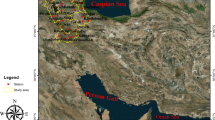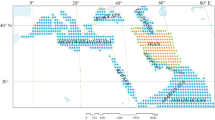Abstract
The purpose of this study is to identify the vertical integrated moisture flux convergence (VIMFC) on the atmosphere of Iran. To achieve this goal, the monthly European Center for Medium range Weather Forecasting gridded data was used during the time period from 1979/1 to 2013/12. Initially, the troposphere was divided into three layers, L1 (850–1000 hPa), L2 (700–775 hPa), and L3 (500–600 hPa) based on the specific moisture amount in the atmosphere. The average long-term rate of VIMFC was plotted for each layers of the troposphere during different months of the year and relationship between VIMFC and precipitation rates was investigated on Iran. On the basis of the time series of the anomalies of the country’s precipitation, the VIMFC’S rates was divided into two periods of 1979–1998 and 1999–2013. To understand the VIMFC shifts in the different layers of the troposphere and its relationship with precipitation, probability distribution function (PDF) for VIMFC and precipitation was calculated. The findings showed that in the warm months, the VIMFC was far more than the cold months of the year and the VIMFC rate in the L1 is also higher than the other layers of the troposphere. Iran’s atmospheric moisture sources at the L1 are southern seas such as Red Sea, Arabic Sean, and Persian Gulf that is being driven toward Iran by Saudi Arabia Dynamic High Pressure System and Sudan’s Low Pressure System. In the L2, the Saudi Arabia Dynamic High Pressure is the most important atmospheric system that sends the moisture of the southern seas to Iran. The PDF shifts of Iran’s precipitation shows a very strong coordination with the VIMFC rate in different months of the year. The findings indicated that in the winter months (JFM), along with decreasing VIMFC rates, the country’s precipitation rate also decreased in the second period of 1999–2013.



















Similar content being viewed by others
References
Alijani B (1995) Climatology of Iran. Payamnoor Publication, Tehran
Alijani B (1997) The climate of Iran. Payam e Noor University Press, 3rd edn. Tehran, Iran
Alizadeh-Choobari O, Zawar-Reza P, Sturman A (2014) The “wind of 120 days” and dust storm activity over the Sistan Basin. Atmos Res 143:328–341
Almazroui M (2006) The Relationships Between Atmospheric Circulation Patterns and Surface Climatic Elements in Saudi Arabia. (PhD Thesis). University of East Anglia, London, UK
Amini F (2016) Monitoring spatio-temporal variance of precipitation overIran in recent decades. Dissertation, University of Kurdistan
Anderson TB, Ruane AC, Roads JO, Kanamitsu M (2009) Estimating the influence of evaporation and moisture-flux convergence upon seasonal precipitation rates. Part II: an analysis for North America based upon the NCEP–DOE reanalysis II model. J Hydrometeorol 10:893–911. https://doi.org/10.1175/2009JHM1063.1
Athar H, Ammar K (2016) Seasonal characteristics of the large-scale moisture flux transport over the Arabian Peninsula. Theor Appl Climatol 124:565–578. https://doi.org/10.1007/s00704-015-1437-7
Chakraborty A, Behera SK, Mujumdar M, Ohba R, Yamagata T (2006) Diagnosis of tropospheric moisture over Saudi Arabia and influences of IOD and ENSO. Mon Weather Rev 134:598–617
Darand M, Mansouri Daneshvar MR (2014) Regionalization of precipitation regimes in Iran using principal component analysis and hierarchical clustering analysis. Environ Proc 1:517–532
Darand M, Doostkamian M, Rehmani MIA (2017) Spatial autocorrelation analysis of extreme precipitation in Iran. Russ Meteorol Hydrol 42(6):415–424
Darand M, Garcia-Herrera R, Asakereh H, Amiri R (2018) Synoptic conditions leading to extremely warm periods in Western Iran. Int J of Climatol 38:307–319
Dayan U, Abramski R (1983) Heavy rain in the Middle East related to unusual jet stream properties. Bull Am Meteorol Soc 64:1138–1140
Diaz HF, Bradley RS (2004) The hadley circulation: present, past, and future, the hadley circulation: present, past and future. Advances in global change research 21. Springer, Dordrecht
Drumond A, Nieto R, Gimeno L (2011) Sources of moisture for China and their variations during drier and wetter conditions in 2000–2004: a Lagrangian approach. Clim Res 50:215–225
Evans J, Smith R, Oglesby R (2003) Pricipitation processes in the Middle East. In: Proceedings international congress on modeling and simulation. Modsim03, Townsville, Australia
Farajzadeh M, Ahmadabad MK, Ghaemi H, Mobasheri MR (2007) Studying the moisture flux over west of Iran: a case study of January 1 to 7, 1996 rain storm. J Appl Sci 7(20):3023–3030
Gimeno L, Stohl A, Trigo RM, Dominguez F, Yoshimura K, Yu L, Drumond A, Durán-Quesada AM, Nieto R (2012) Oceanic and terrestrial sources of continental precipitation. Rev Geophys 50:RG4003
Hiyama H et al (2016) Recent interdecadal changes in the interannual variability of precipitation and atmospheric circulation over northern Eurasia. Environ Res Lett 11:065001
Holloway CE, Neelin JD (2009) Moisture vertical structure, column water vapor, and tropical deep convection. J Atmosp Sci 66:1065–1083
Holloway CE, Neelin JD (2010) Temporal relations of column water vapor and tropical precipitation. J Atmos Sci 67:1091–1105
Hoskins B (1996) On the existence and strength of the summer subtropical anticyclones: Bernhard Haurwitz memorial lecture. Bull Am Meteorol Soc 77:1287–1292
Hudson HR (1970) On the relationship between horizontal moisture convergence and convective cloud formation. Appl Meteorol 10:755–762
IPCC (2007) Contribution of working groups I, II and III to the fourth assessment report of the intergovernmental panel on climate change. Geneva, Switzerland
Kalkstein LS, Tan G, Skindlov JA (1987) An evaluation of three clustering procedures for use in synoptic climatological classification. J Appl Meteorol Climatol 26:717–730
Lashkari H, Khalilian V (2012) Synoptic analysis of the precipitation zone of the Sudanese-Mediterranean integration system on Iran. Sepehr Geograph Inf 21(84):21–34
Lashkari H, Mohammadi Z (2018) Study on the role of annual movements of Arabian subtropical high pressure in the late start of precipitation in southern and southwestern Iran. Theor Appl Climatol. https://doi.org/10.1007/s00704-018-2716-x
Levine RC, Turner AG (2012) Dependence of Indian monsoon precipitation on moisture fluxes across the Arabian Sea and the impact of coupled model sea surface temperature biases. Clim Dyn 38:2167–2190. https://doi.org/10.1007/s00382-011-1096-z
Li X, Wen z, Zhou W, Wang D (2012) Atmospheric water vapor transport associated with two decadal precipitation shifts over East China. Meteorol Soc Jpn 90(5):587–602. https://doi.org/10.2151/jmsj.2012-501
Lu E et al (2014) The atmospheric anomalies associated with the drought over the Yangtze River basin during spring 2011. J Geophys Res Atmos 119:5881–5894. https://doi.org/10.1002/2014JD021558
Mailk MK, Taylor PA, Szeto K (2015) Characteristics of moisture flux convergence in Central Southwest Asia. Theor Appl Climatol 120:643–659. https://doi.org/10.1007/s00704-014-1192-1
Malik Kh, Taylor PA (2011) Characteristics of Moisture flux convergence over the Mackenzie River basin for water years 1991–2008. Atmos Ocean 49(3):279–288
Pazhoh F (2017) Analysis and monitoring the drought in Kavir & Desert Region and Makran Coasts through the different drought index. Defense strategy research center, Tehran
Ratna SB, Cherchi A, Joseph PV, Behera S, Abish B, Masina S (2014) Moisture trend over the Arabian Sea and its influence on the indian summer monsoon precipitation. Cmcc Res 225:28–50
Ricko M (2007) Water and energy budgets over the Mediterranean Sea and differences between East and West Mediterranean basins. Proj Rep 658:1–27
Rodwell MJ, Hoskins BJ (1996) Monsoons and the dynamics of deserts. Quart J R Meteorol Soc 122:1385–1404
Rogash JA, Smith RD (2000) Multiscale overview of a violent tornado outbreak with attendant flash flooding. Weather Forecast 15:416–431
Rohini P, Rajeevan M, Srivastava AK (2016) On the variability and increasing trends of heat waves over India. Sci Rep 6:26153. https://doi.org/10.1038/srep26153
Roshani A, Parak F, Hejazizadeh Z, Ghaemi H (2013) Studying the moisture flux over south and southwest of Iran: A case study from december 10 to 13, 1995 rain storm. Earth Sci Res 2(2):34–39
Ruiz-Barradas A, Nigam S (2005) Warm season precipitation variability over the U.S. Great plains in observations, NCEP and ERA-40 reanalyses, and NCAR and NASA atmospheric model simulations. J Clim 18:1808–1830
Ruiz-Barradas A, Nigam S (2013) Atmosphere-land surface interactions over the southern Great Plains: characterization from pentad analysis of DOE ARM field observations and NARR. J Clim 26:875–886
Sahin M, TURKES M, Wang SH, Hannah D, Eastwood W (2015) Large scale moisture flux characteristics of the Mediterranean basin and their relationships with drier and wetter climate conditions. Clim Dyn 45:3381–3401. https://doi.org/10.1007/s00382-015-2545-x
Smith RB, Jiang Q, Fearon MG, Tabary P, Dorninger M, Doyle JD, Benoit R (2003) Orographic Pricipitation and air mass transformation: an Alpine example. QJR Meteorol Soc 129:433–454. https://doi.org/10.1256/qj.01.212
Tyrlis E, Lelieveld J, Steil B (2013) The summer circulation over the eastern Mediterranean and the Middle East: influence of the South Asian monsoon. Clim Dyn 40:1103–1123
Warner TT (2009) Desert meteorology. Cambridge University Press, Cambridge
Wei J, Su H, Yang ZL (2015) Impact of moisture flux convergence and soil moisture on precipitation: a case study for the southern United States with implications for the globe. Clim Dyn. https://doi.org/10.1007/s00382-015-2593-2
Yang H, Sun S (2005) The characteristics of longitudinal movement of the subtropical high in the western Pacific in the pre-rainy season in South China. Adv Atmos Sci 22:392–400
Author information
Authors and Affiliations
Corresponding author
Additional information
Publisher’s Note
Springer Nature remains neutral with regard to jurisdictional claims in published maps and institutional affiliations.
Rights and permissions
About this article
Cite this article
Darand, M., Pazhoh, F. Vertically integrated moisture flux convergence over Iran. Clim Dyn 53, 3561–3582 (2019). https://doi.org/10.1007/s00382-019-04726-z
Received:
Accepted:
Published:
Issue Date:
DOI: https://doi.org/10.1007/s00382-019-04726-z




